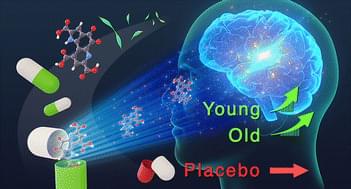Meta seems to already have good AI tools.
Meta’s ESMFold AI is a large language model like OpenAI’s ChatGPT. But instead of spitting out text, it generates protein sequences.

Join us on Patreon! https://www.patreon.com/MichaelLustgartenPhD
Discount Links:
NAD+ Quantification: https://www.jinfiniti.com/intracellular-nad-test/
Use Code: ConquerAging At Checkout.
Green Tea: https://www.ochaandco.com/?ref=conqueraging.
Oral Microbiome: https://www.bristlehealth.com/?ref=michaellustgarten.
Epigenetic Testing: https://bit.ly/3Rken0n.
Use Code: CONQUERAGING!
At-Home Blood Testing: https://getquantify.io/mlustgarten.

Johns Hopkins APL’s Civil Space Mission Area makes critical contributions to NASA and international missions to meet the challenges of space science, engineering, and exploration.
Since the dawn of the Space Age, APL has pushed the frontiers of space science, engineering and exploration. We captured the first picture of Earth from space, invented navigation by satellite, dispatched spacecraft across the solar system from our Sun to Pluto and beyond, and successfully conducted the world’s first full-scale planetary defense test mission.
We continue to shape the future by providing our nation with innovative and low-cost solutions to its space challenges. Our work includes conducting research and space exploration; development and application of space science, engineering, and technology; and production of one-of-a-kind spacecraft, instruments, and subsystems.

Brain function is important for a good quality of life. Pyrroloquinoline quinone disodium salt (PQQ) has been proven to improve brain function and cognition in older adults (above 45 years). In this double-blind, placebo-controlled study, we investigated the effects of PQQ on cognitive function in adults aged between 20 and 65 years. PQQ (20 mg per day) was administered for 12 weeks to the participants. After 12 weeks, the participants showed improvements in composite memory and verbal memory. A further age-stratified analysis was performed. In younger adults (aged 20–40 years), PQQ improved cognitive function (cognitive flexibility, processing speed, and execution speed) after 8 weeks. Only older adults (aged 41–65 years) showed improvements in complex and verbal memory after 12 weeks. In the logistic regression analysis that included the results of all cognitive tests, the changes due to PQQ intake were observed at 8 and 12 weeks in the young and old groups, respectively.

A trojanized version of the legitimate ChatGPT extension for Chrome is gaining popularity on the Chrome Web Store, accumulating over 9,000 downloads while stealing Facebook accounts.
The extension is a copy of the legitimate popular add-on for Chrome named “ChatGPT for Google” that offers ChatGPT integration on search results. However, this malicious version includes additional code that attempts to steal Facebook session cookies.
The publisher of the extension uploaded it to the Chrome Web Store on February 14, 2023, but only started promoting it using Google Search advertisements on March 14, 2023. Since then, it has had an average of a thousand installations per day.

University of Pittsburgh.
A metamaterial is any material engineered to have a property that is elusive to naturally occurring materials. The research introduces the use of metamaterials in the creation of concrete, providing the option to alter its brittleness, flexibility, and shapeability to allow builders to use less of the material without sacrificing strength or longevity.
🔥 Explore Advanced Certification In UI UX Design by Simplilearn: https://www.simplilearn.com/ui-ux-certification-training-cou…ce=youtube.
🔥 Explore Artificial Intelligence Engineer (Discount Coupon:
YTBE15): https://www.simplilearn.com/masters-in-artificial-intelligen…ce=youtube.
In this video, “Top 10 AI Tools for Designers 2023,” we will learn about the top 10 AI tools and their features, pros, and cons. Also, we will cover the Best AI tools for Designers as per the features and pricing. Finally, we will pick the best among the top 10 AI tools.
Below are the topics we will discuss in this “AI Tools for Designers“
00:00 AI Tools for Designers.
01:46 Sketch2Code.
03:16 UiZard.
05:16 DEsign.ai.
07:09 Fronty.
09:12 Color.adobe.
11:22 Lets Enhance.
13:50 Picksart.
15:35 Runway ML
🔥 What is Artificial Intelligence?
- Artificial Intelligence is becoming increasingly necessary in the design industry, offering new and innovative tools for designers to use. Although AI tools can enhance designers’ efficiency, creativity, and productivity, it’s important to remember that human touch and creativity remain essential elements in design.
⏩As we have discussed, there are 10 AI Tools, but PicsArt is a popular photo editing tool that stands out from other tools in several ways. One key advantage of PicsArt is the wide range of features it offers. The app includes advanced photo editing tools, filters, text, stickers, frames, and collage makers, providing users various creative options.
Another advantage of PicsArt is its user-friendly interface, which is easy to navigate even for beginners. The app also provides tutorials and tips to help users understand and utilize its various features and tools.
🔥 Enroll for Free Courses by Simplilearn: https://www.simplilearn.com/learn-ai-basics-skillup?utm_camp…e=youtube.


Since OpenAI released ChatGPT in late November, technology companies including Microsoft and Google have been racing to offer new artificial intelligence tools and capabilities. But where is that race leading?
Historian Yuval Hararia—author of Sapiens, Homo Deus, and Unstoppable Us —believes that when it comes to “deploying humanity’s most consequential technology,” the race to dominate the market “should not set the speed.” Instead, he argues, “We should move at whatever speed enables us to get this right.”
Hararia shared his thoughts Friday in a New York Times op-ed written with Tristan Harris and Aza Raskin, founders of the nonprofit Center for Humane Technology, which aims to align technology with humanity’s best interests. They argue that artificial intelligence threatens the “foundations of our society” if it’s unleashed in an irresponsible way.

Your circadian rhythm doesn’t just govern your sleeping schedule; it can also impact cancer development, diagnosis, and treatment. In a review paper published in the journal Trends in Cell Biology, researchers discuss the role of circadian rhythms in tumor progression and spread and describe how we could better time when patients are tested for cancer and when they receive therapies to improve diagnostic accuracy and improve treatment success.
“The circadian rhythm governs most of the cellular functions implicated in cancer progression, and therefore its exploitation opens new promising directions in the fight against metastasis,” write the authors, molecular oncologists Zoi Diamantopoulou, Ana Gvozdenovic, and Nicola Aceto from the ETH Zurich in Switzerland.
Our circadian rhythms help our bodies synchronize different tasks throughout the day, including gene expression, immune function, and cell repair. We’ve long known that chronically disrupted circadian rhythms—as a result of erratic sleep patterns, jet lag, or shift work, for example—can predispose us to a number of health issues, including cancer. More recent work has shown that circadian rhythms are not only involved in tumor onset, but also govern cancer progression and metastasis, the colonization of secondary sites within the body.